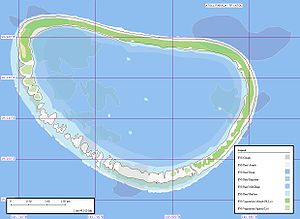Paraoa
| Paraoa | ||
|---|---|---|
| NASA image of Paraoa | ||
| Waters | Pacific Ocean | |
| archipelago | Tuamotu Archipelago | |
| Geographical location | 19 ° 8 ′ S , 140 ° 41 ′ W | |
|
|
||
| Land area | 4 km² | |
| Lagoon area | 14 km² | |
| Residents | uninhabited | |
| Map of Paraoa | ||
Paraoa , other names: Tohora, Hariri, Gloucester Island , is a small, uninhabited island in the South Pacific that geographically belongs to the Tuamotu Archipelago .
geography
The almost oval atoll measures 8.5 × 5.5 km, but has a land area of just 4 km². The 14 km² large lagoon of the atoll is completely enclosed by a coral reef that has no navigable access. The north and northeast side is formed by a long coral island, only 250 m wide on average, which covers around two thirds of the atoll. The water exchange between the lagoon and the ocean takes place through shallow hoa on the south side of the fringing reef, which separate several small motus from each other.
The vegetation is largely untouched; its composition corresponds to the flora of the flat coral islands of the other Tuamotus (see → Tuamotu Archipelago # Flora ). In the northwest of the main island, a small area was cleared and a coconut plantation was created, probably during the copra boom in the late 19th and early 20th centuries. Today the plantation is only visited sporadically for harvest.
history
It is not known whether the island was ever permanently inhabited by Polynesians . Due to the complete lack of fresh water, the small land area and limited resources, this is unlikely. An archaeological exploration has not yet taken place. In 1767, however, Wallis noticed around 16 Polynesians wielding spears threateningly while they were driving past the west coast, but saw no canoes and no evidence of a settlement. It is therefore more likely that they were temporary visitors from another island.
The British naval officer and circumnavigator Samuel Wallis discovered Paraoa for Europe. On the way from the Strait of Magellan to Tahiti , the Dolphin passed an unknown island on June 11, 1767, which Wallis baptized "Gloucester Island" after William Henry, Duke of Gloucester and Edinburgh , the younger brother of King George III. Since Wallis did not expect to be able to take up water and food on the tiny island, which had few resources, he decided not to land, which he thought was dangerous because of the numerous reefs, the high surf and the strong wind. Wallis notes in his notes that although the island was densely forested, he did not see any coconut trees .
The British polar explorer and geographer Frederick William Beechey reached Paraoa in February 1826. He did not go ashore either because he feared he would be driven onto the cliffs because of the strong surf. Beechey also saw no signs of any residents.
The researchers of the "Whitney South Seas Expedition", whose primary aim was to study the Pacific bird life and collect bird specimens for the American Museum of Natural History , visited Paraoa on June 28, 1922 and collected a specimen of the curlew (Numenius tahitiensis ).
Politics and administration
Politically, the uninhabited island belongs to the French Overseas Zealand ( Pays d'outre-mer - POM ) French Polynesia and is administered by the municipality of Hao .
See also
Individual evidence
- ↑ JL Young: Names of the Paumotu Islands ; in: The Journal of the Polynesian Society , Volume 8 (4) from December 1899, pp. 264–268 ( http://www.jps.auckland.ac.nz/document.php?wid=368&action=null online)
- ^ A b John Hawkesworth: Voyages in the Southern Hemisphere , Vol 1, London 1773, pp. 429-430
- ^ Frederick William Beechey: Narrative of a Voyage to the Pacific and Bering's Strait to Co-Operate with the Polar Expeditions: Performed in His Majesty's Ship Blossom, Under the Command of Captain FW Beechey, RN in the Years 1825, 26 , 27.28, London 1831, pp. 225-226
- ^ Eleanor Herrick Stickney: Birds Collected During the Whitney South Sea Expedition; in: American Museum Novitates, No. 1248, New York City 1943, p. 5


